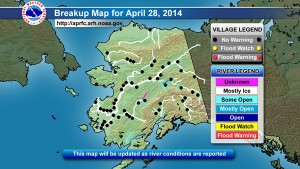Feeling lucky #akriverwatch is calm today. Prayers for recovery in #tupelo and those in the path of #tornado. pic.twitter.com/02pmv0xGvC
— Alaska DHS&EM (@AlaskaDHSEM) April 28, 2014
Teams are heading out to keep an eye on breakup conditions along Alaska’s largest river systems. The National Weather Service is predicting below average flooding this year, but the state wants villages to be ready just in case.
Even though flooding caused by this spring’s breakup should be less severe than normal, the State Division of Homeland Security and Emergency Management spokesman Jeremy Zidek says Interior communities could still see some flooding.

“Generally, when we see the below-average years and we do experience flooding, it’s one community, not a series of communities like we saw last year with the flooding all along the Yukon River,” Zidek said.
Galena was devastated last year after an ice jam caused a massive flood, keeping much of the town underwater for days and forcing most residents to evacuate. Once the waters receded, residents returned to largely unsalvageable homes and other problems from lack of power, to spoiled food.
The village of Circle and several other Interior communities were also hit by flooding.
Zidek says the first river watch team has already been deployed to the Upper Yukon River and is stationed in Circle Hot Springs.
“Generally, we do launch our river watch program a little bit later in the year,” he said. “There’s been higher than normal temperatures in the Interior and there’s a lot of reports of ice moving early in the sloughs and small tributaries that feed into the major rivers.”
Keep an eye in the sky for our #akriverwatch teams. Please tweet your #akbreakup pictures and reports. pic.twitter.com/vh0qAYfZHO
— NWS APRFC (@NWSAPRFC) April 28, 2014
Each river watch team consists of three people: a local pilot, a National Weather Service river forecast center hydrologist, and a Division of Homeland Security and Emergency Management emergency manager. Zidek says each team monitors a particular section of the river, tracking the breakup process.
“For the most part it is aerial observations,” Zidek said. “The river forecast center takes those aerial observations, past models, and also other observations that have been made along the river system where people just provide their own feedback, put that all together and make their flood potential forecasts, and if there’s any issues, they can issue the flood warnings and advisories.”
If the teams do spot something that might be troubling for nearby communities, the emergency manager will land and consult with the local residents and coordinate with the state emergency office.
Five river watch teams will be deployed – three to the Yukon River and two to the Kuskokwim River.
Josh is the Statewide Morning News Reporter/Producer for Alaska Public Media | jedge (at) alaskapublic (dot) org | 907.550.8455 | About Josh




